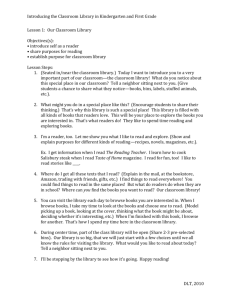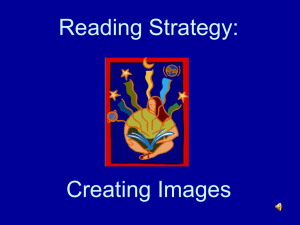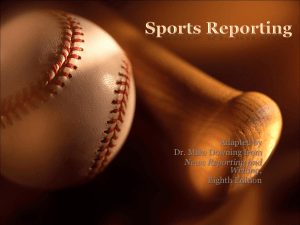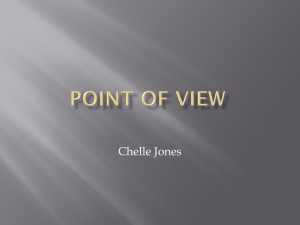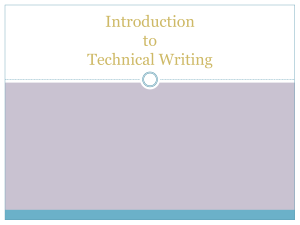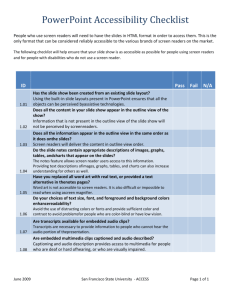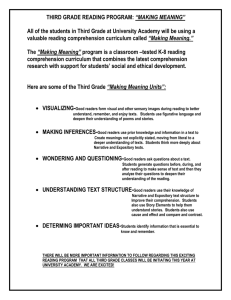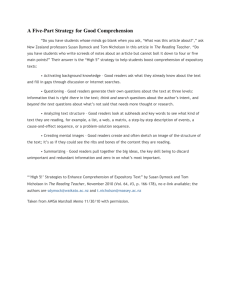Anchor Lesson
advertisement
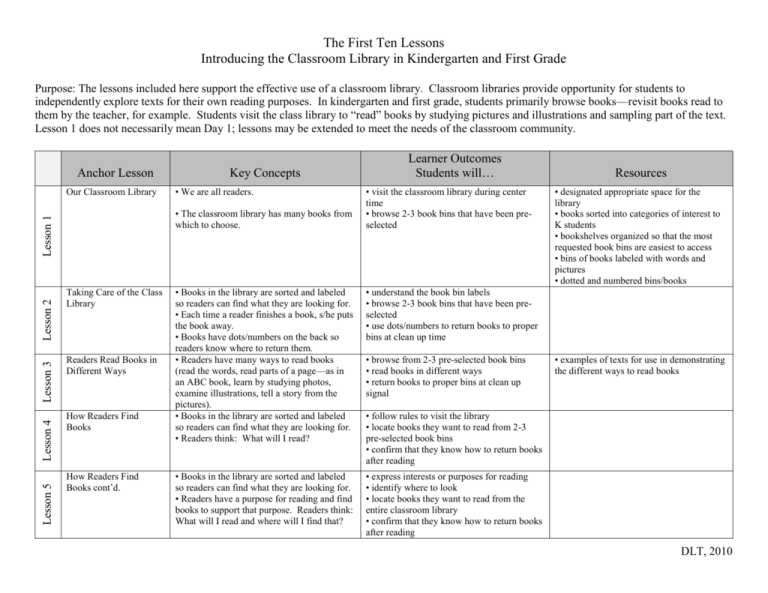
The First Ten Lessons Introducing the Classroom Library in Kindergarten and First Grade Purpose: The lessons included here support the effective use of a classroom library. Classroom libraries provide opportunity for students to independently explore texts for their own reading purposes. In kindergarten and first grade, students primarily browse books—revisit books read to them by the teacher, for example. Students visit the class library to “read” books by studying pictures and illustrations and sampling part of the text. Lesson 1 does not necessarily mean Day 1; lessons may be extended to meet the needs of the classroom community. Anchor Lesson Our Classroom Library • We are all readers. • The classroom library has many books from which to choose. Lesson 1 Lesson 2 Lesson 3 Lesson 4 Lesson 5 Key Concepts Taking Care of the Class Library Readers Read Books in Different Ways How Readers Find Books How Readers Find Books cont’d. Learner Outcomes Students will… • visit the classroom library during center time • browse 2-3 book bins that have been preselected • Books in the library are sorted and labeled so readers can find what they are looking for. • Each time a reader finishes a book, s/he puts the book away. • Books have dots/numbers on the back so readers know where to return them. • Readers have many ways to read books (read the words, read parts of a page—as in an ABC book, learn by studying photos, examine illustrations, tell a story from the pictures). • Books in the library are sorted and labeled so readers can find what they are looking for. • Readers think: What will I read? • understand the book bin labels • browse 2-3 book bins that have been preselected • use dots/numbers to return books to proper bins at clean up time • Books in the library are sorted and labeled so readers can find what they are looking for. • Readers have a purpose for reading and find books to support that purpose. Readers think: What will I read and where will I find that? • express interests or purposes for reading • identify where to look • locate books they want to read from the entire classroom library • confirm that they know how to return books after reading • browse from 2-3 pre-selected book bins • read books in different ways • return books to proper bins at clean up signal Resources • designated appropriate space for the library • books sorted into categories of interest to K students • bookshelves organized so that the most requested book bins are easiest to access • bins of books labeled with words and pictures • dotted and numbered bins/books • examples of texts for use in demonstrating the different ways to read books • follow rules to visit the library • locate books they want to read from 2-3 pre-selected book bins • confirm that they know how to return books after reading DLT, 2010 The First Ten Lessons Introducing the Classroom Library in Kindergarten and First Grade Purpose: The lessons included here support the effective use of a classroom library. Classroom libraries provide opportunity for students to independently explore texts for their own reading purposes. In kindergarten and first grade, students primarily browse books—revisit books read to them by the teacher, for example. Students visit the class library to “read” books by studying pictures and illustrations and sampling part of the text. Lesson 1 does not necessarily mean Day 1; lessons may be extended to meet the needs of the classroom community. Lesson 10 Key Concepts Resources • Readers make choices when they visit the classroom library (based on purpose for reading). • Readers can preview books to make choices—“Is it interesting?” • When we finish one book, we return it to the proper bin and select another. • There are many kinds of books in the world. • Our library includes many different kinds of books. • What are we interested in reading? • understand the expectations and follow the rules for reading independently at the classroom library • examine covers and illustrations to select interesting books to browse • rules posted with illustrations or photographs to support • know the reading choices offered by the classroom library • share their ideas for other topics, characters, etc. • a form for recording reading preferences (ex. choose a topic, draw a picture, and use invented spelling to label) Readers Have Favorites • When browsing the classroom library, readers like to reread favorite books. • begin to identify and select favorite books for rereading • begin to think about ways to respond orally to text • a favorite text to use in teacher demonstration: “I read a favorite book today. It’s one of my favorites because…” Sharing Time • At the end of center time, we have a chance to share something we learned from our center work. • Readers can share what they learned or noticed during browsing in the classroom library. • We all do our best work when everyone in the classroom observes established rules. • We will add books to the library throughout the year. • To decide where to put a book, we think: What is it mostly about? • recognize that the sharing after centers is a learning time • share responses to text with others following centers • become accountable for the productive use of time • reflect on how well the rules for visiting the library are being followed • use the title, cover, and picture walk to determine topic of book • identify where to place the book • create illustrations for book bin labels • gathering area for whole class sharing Readers Need Time to Explore their Interests Readers Read a Variety of Texts Lesson 9 Lesson 8 Lesson 7 Lesson 6 Anchor Lesson Learner Outcomes Students will… Keeping it Going and Growing • new book(s) for the library (may be a new topic students indicated an interest in ) • labeled bin and dotted/numbered book(s) DLT, 2010
